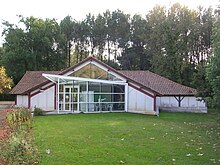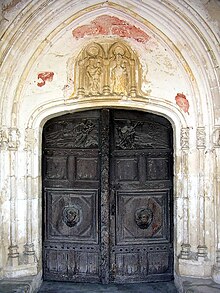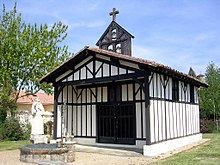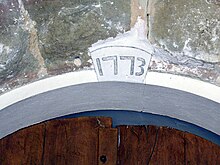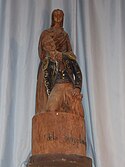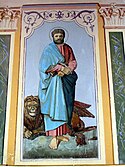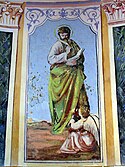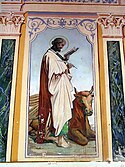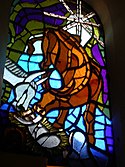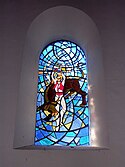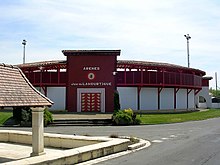Bascons
| Bascons | ||
|---|---|---|
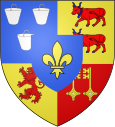
|
|
|
| region | Nouvelle-Aquitaine | |
| Department | Country | |
| Arrondissement | Mont-de-Marsan | |
| Canton | Adour Armagnac | |
| Community association | Pays Grenadois | |
| Coordinates | 43 ° 49 ′ N , 0 ° 25 ′ W | |
| height | 66-107 m | |
| surface | 18.70 km 2 | |
| Residents | 845 (January 1, 2017) | |
| Population density | 45 inhabitants / km 2 | |
| Post Code | 40090 | |
| INSEE code | 40025 | |
| Website | www.bascons.fr | |
 Parish Church of Saint-Amand |
||
Bascons is a French municipality with 845 inhabitants (at January 1, 2017) in the department of land in the region Nouvelle-Aquitaine (before 2016: Aquitaine ). The municipality belongs to the arrondissement of Mont-de-Marsan and the canton of Adour Armagnac (until 2015: canton of Grenade-sur-l'Adour ).
The name in the Gascognischen language is also Bascons . It is a sound shift of the word Vascons , a name given by the Basques who colonized the area north of the Pyrenees in the early Middle Ages .
The inhabitants are called Basconnais and Basconnaises .
geography
Bascons is located about 10 km southeast of Mont-de-Marsan in the Pays de Marsan region of the historic province of Gascony on the southeastern edge of the department.
Bascons is surrounded by the neighboring communities:
| Mazerolles | Laglorieuse | Artassenx |
| Brittany-de-Marsan |

|
Maurrin |
| Saint-Maurice-sur-Adour | Grenade-sur-l'Adour |
Bascons lies in the catchment area of the River Adour . One of its tributaries, the Ruisseau du Bos , here also called Ruisseau des Longs , crosses the territory of the municipality. The Ruisseau de Caillaou, a tributary of the Ruisseau de Courdaoute, has its source in Bascons.
history
St. Amand of Maastricht (575–676) had a decisive influence on the village. After his exile by the Frankish King Dagobert I , he went to Aquitaine to proselytize the Basques . According to tradition, he is said to have baptized converts at the well in Bascons. He also has a chapel consecrated in Bascons and probably a convent of Benedictine , who later by the Normans was destroyed. In the Middle Ages , Bascons was the seat of the Cour dels Sers , the court of the Vicomté of Marsan. The castle of Bascons was bequeathed to her sister Marguerite de Béarn from the Viscountess Constanze in 1310. During the English occupation, Edward of Woodstock , also known by his nickname "The Black Prince", stayed in Bascons for a long time. In 1460 the Vicomté of Marsan became part of the Béarn. The village suffered from the consequences of the Huguenot Wars in the 16th century, because in 1569 the church was set on fire. The fronde also had its effects in the 17th century . The Marsan Sénéchaussée took the side of the princes and Bascons hosted the troops of the Chevalier d'Aubeterre.
Population development
In the 18th century the Bascons still had 3,000 inhabitants. The population showed a high of 1150 in the first half of the 19th century. In the following period, the size of the community fell to around 535 by the 1940s, before a period of growth began until after the turn of the millennium, which finally brought the size of the community to around 940 inhabitants raised. Since then, the number of residents has shown a downward trend again.
| year | 1962 | 1968 | 1975 | 1982 | 1990 | 1999 | 2006 | 2010 | 2017 |
|---|---|---|---|---|---|---|---|---|---|
| Residents | 594 | 620 | 608 | 673 | 823 | 867 | 941 | 912 | 845 |
Town twinning
Bascons maintains since 1993 a twinning with:
-
 Bartenheim in the Haut-Rhin department in Alsace in the Grand Est region .
Bartenheim in the Haut-Rhin department in Alsace in the Grand Est region .
On September 1, 1939, on the day of the attack on Poland by German armed forces, the residents of Bartenheim received instructions to evacuate. After several days, the Bartenheimers arrived in Bascons, where they were warmly welcomed. They stayed until September 1940 before returning to their village.
Culture and sights
Museums
Course Landaise Museum
The Course Landaise is a traditional, bloodless game with wild bulls. Bascons is the only parish in the country with two arenas where the game is played, every year on Ascension Day , on July 22nd, the feast of St. Mary Magdalene , and on August 15, the feast of the Assumption of Mary . Information boards, videos and exhibits enable visitors to get to know the history and culture of traditional sport. The last renovations in 2004 mainly included the establishment of a demonstration room and an area for temporary exhibitions. The museum is open from April to October.
Buildings
Parish Church of Saint-Amand
It is dedicated to St. Amand of Maastricht. The building was originally a medieval castle. After being set on fire in 1569, it was rebuilt in Gothic style at the end of the 16th century . A stone embedded in the northern outer wall bears the year "1601". The new building was probably not completed until 1626, as a corresponding year on a keystone can prove. At the same time, the aisle was added on the north side. In the west, the bell gable with five arches for the bells from 1818 and two supporting buttresses is flanked by a tourelle . The church still shows elements of a defensive character with a battlement below the roof, remains of loopholes for archers and field snakes as well as a cast core above the apse and the entrance portal .
The portal with archivolts has a Gothic tympanum from the 16th century. It shows in relief Mary with baby Jesus accompanied by the patron saint of the church, St. Amand. Two of the capitals, otherwise decorated with foliage , in the drapery on the right-hand side fall out of the frame. Two pigs can be seen on one, a bagpiper on the other . This very vivid iconography symbolizes the dance, which is supposed to be responsible for lust , one of the seven deadly sins of the Catholic Church. The two door wings of the portal were made in 1676 and are the work of the artist Lalande from Mont-de-Marsan. They take up the motif of the tympanum and follow an iconography that is determined by the Counter-Reformation . Its purpose was to revive the faith of the parishioners, which had been shaken by the Huguenot Wars. On the left wing Mary with the baby Jesus is depicted, on the right St. Amand in a bas-relief. Both seem to be walking through a stormy, distorted landscape. Amand wears a bishop's miter , holds a crook in his left hand and raises the right as a sign of blessing.
The interior of the church is richly decorated with numerous statues of saints and apostles , three altarpieces and keystones with various motifs. Most of the elements date from the 17th century. The main nave measures 18.50 m in length, 7 m in width and 9.50 m in height. It is surmounted by a four-part ribbed vault . In the 19th century the church was also visited for the blessing of the oil, called Saint-Louis , which is said to have been known for its anti- inflammatory effects . Every year on August 15th there is a pilgrimage to the parish church.
The reredos of the main altar were erected in the 17th century as a replacement for the destroyed display wall. In the middle, a statue of Christ crucified occupies the place that was previously occupied by a painting that has now disappeared. The altar and tabernacle have also been replaced by newer works. The heads of cherubins rest on four ornate serpent columns that frame two statues. These bear the attributes of a bishop, miter and crook. It seems like the statues both represent the patron saint of the church. Above the frieze there is a wooden structure with a painting illustrating the Trinity . The painting is framed by two caryatids , who carry vases with flames on their heads.
In the north aisle is the retable, which was originally dedicated to Saint Joseph , but is now dedicated to Margaret Maria Alacoque . Its decoration, with serpentine columns, with black and white stucco ornaments and the niches surmounted by cherubins, expresses its baroque style, which was widespread in south-west France in the 17th century. The painting in the middle tells of the apparition of the Heart of Jesus to Margareta Maria Alacoque. On the sides are statues of Saints Joachim and Elisabeth , both made of painted wood in 1717. The elaboration of the face and hands, the use of bright colors and the details of Joachim's coat reveal a Spanish art style that has been highly valued on this side of the Pyrenees since the 18th century. The original altar and tabernacle were also replaced in this reredos.
In the north aisle, a small altar is surmounted by a niche in which a statue of Christ made of polychrome wood stands. It dates from the 17th century and illustrates the scene “Christ on the Scourge Column ”. The gable above the niche bears the inscription Ecce homo cujus livore sanati sumus ( German, see, the man whose wounds have healed us ), which is distributed partly on a roll of parchment and partly on a drapery held by two angels . The work is accompanied by a second statue from the 17th century, also in a niche, depicting St. Anne teaching Mary to read.
On the first pillar of the north aisle, a painting shows the patron saint of the church with a miter and a crook. He blesses a fountain dedicated to him and in the background a landscape from which the parish church rises. The work is part of a collection of eight paintings distributed under the arcades that open the aisle to the nave .
The parish church has been classified as Monument historique since September 23, 1970, most of the furnishings since September 1, 1986 or December 11, 1989 .
Saint-Amand chapel
To the west of the parish church is a small half-timbered chapel . It was built in 1946 and has a roof turret. In front of the chapel there is a fountain whose water is said to have healing properties. Originally, the sick came to Bascons hoping to cure their rickets . Today the children who suffer from eczema or other skin diseases are brought along . Especially on the occasion of the local festival, numerous residents of the Landes come to take the water with them in vessels or moisten handkerchiefs to place on their or their children's faces.
Notre-Dame-de-la-Course-Landaise chapel
It is dedicated to St. Mary to protect the participants in the Course Landaise. The chapel in the Bostens district north of the center of the parish and not far from the museum was consecrated to St. Mary Magdalene, patron saint of the parish of Bostens, until 1970. It borders on a cemetery where members of the old families of the neighborhood are still buried today. The year “1773” on the lintel of the entrance door indicates the date of its construction. In the second half of the 20th century, the chapel was restored on May 7, 1970 their new dedication inaugurated . Every year on Ascension Day, there is a pilgrimage for the participants of the Course Landaise with a church service and a posthumous tribute to a leading figure in the sport. The building is 18 m long and 6 m wide with a closed, tiled porch in front of the entrance. It has a small triangular bell gable with a cross at its top, which is interrupted by two openings for the bells, which are protected on both sides by small canopies. The nave with a nave is extended by a semicircular apse. On one wall of the nave hangs an oil painting from the 17th century, showing Mary Magdalene praying in a rock grotto. On the back wall of the choir is a statue of the patron saint of the chapel in the representation of the Pietà , which shows Mary with Christ in her arms, who was previously taken from the cross. It was created in 1970 from polychrome wood by the Spanish artist Martin Gallesteguy based on a drawing by François Meyney, known as Francel. Around the choir hang pictures of the four evangelists in bright colors, which can be recognized by their evangelist symbols, Mark on the lion , John on the eagle , Matthew on the winged person and Luke on the bull . The restoration of these pictures was carried out by the artist Blanc from Nîmes in the Gard department , who lived as a refugee in Mont-de-Marsan during the last war . The table of the altar rests on a wooden sculpture depicting the horns of cows. The three glass windows with bright colors were created during the restoration of the chapel. Two of them illuminate the choir, one of them illustrates the scene of the Christmas crib with a cow licking the baby Jesus, the other shows Mary at the foot of the cross with Roman soldiers in the background. The third glass window is set into the wall of the nave and is an echo of the bullfight in the country with a representation of a jump. Another reference to sport is the gallery above the nave. A small spiral staircase with 13 steps leads to three wooden treads, reminiscent of the grandstand of an arena.
Arena Jean de Lahourtique
It bears the name of Jean de Lahourtique, whose real name was Jean Diris. He served as a justice of the peace in the cantons of Amou and Hagetmau and was the reporter and editor-in-chief of the newspaper “La course landaise”. His portrait, a work by Cel Le Gaucher, hangs over the entrance of the arena, which was built according to plans by the architect Franck Bonnefous from Mont-de-Marsan as a replacement for earlier wooden structures that were erected as required in the square in front of today's Frontón were. The arena was inaugurated on August 15, 1936. It corresponds to the typical construction with roofed stands above boxes . In 1971 the uncovered rows of seats were rebuilt with reinforced concrete , and in 2004 restoration work embellished the upper part of the main facade with a cantilever with wooden shingles . Today's visitor capacity is 1,200 places, 380 of which are covered. The field measures 37 m × 25 m. The arena has been classified as a monument historique since April 25, 2007 .
Arena in the Boston district
The arema in the Boston district is older and much smaller than the arena Jean de Lahourtique. It has a semi-permanent grandstand with 80 seats.
Cenotaph for the fallen soldiers of the First World War
It is located on the church square in front of the north side of the parish church. A first memorial was erected not far from the church in 1921. But after the Second World War , the community asked Marcel Ganguillem, called Cel le Gaucher, to build a new memorial with larger regional references. It is determined by a bas-relief that depicts the “Méninotte”, an old woman from the country crying inconsolably for her children. Poilus can be seen between and next to the two plaques with the names of the soldiers who died in the First World War . The memorial has been classified as a Monument historique since October 21, 2014 .
Economy and Infrastructure
Trade and services are the main economic drivers of the community.

total = 49
education
The community has a public preschool and elementary school with 78 students in the 2017/2018 school year.
sport and freetime
A circular path over a length of 13.4 km leads from the center through the area of the municipality, in particular past the Bostens district with its chapel, museum and arena.
traffic
The Bascons is crossed by Routes départementales 351 and 406.
Personalities
Born in Mont-de-Marsan, Marcel Canguilhem (1895–1949), known as Cel le Gaucher, was a cartoonist , commercial artist , illustrator and sculptor. During the First World War he lost his right arm, so that from then on he could only use his left hand for his work. From then on he signed with "Cel le Gaucher" ( German Cel, the left-hander ). He was known and appreciated by the fans of the Course Landaise. One of his works, “L'écart d'Henri Meunier”, is the logo of the Fédération Française de la Course Landaise . The association with Bascons resulted from friendship with then Mayor Raoul Laporterie and resulted in the creation of several works that can be seen in Bascons:
- the memorial for the fallen of the First World War,
- Steles of Vincent de Paul and the pastor Bordes (1880–1944), a fighter of the Resistance on the north wall of the parish church,
- Bas-reliefs with the portraits of Dr. Dupouy and Dr. Lataste, two former mayors of the Bascons, at the entrance of the Frontón,
- a bust of the artist himself in the garden of the town hall,
- the portrait of Jean de Lahourtique above the entrance to the arena and
- Statues of St. Mary and St. Bernadette Soubirous on the corner of the Route du Bas-Armagnac.
Web links
- Bascons on the association's website (French)
- Course Landaise Museum website (French)
Individual evidence
- ↑ Bascons ( fr ) Gasconha.com. Retrieved January 19, 2018.
- ↑ a b Bascons historique ( fr ) municipality of bascons. Retrieved January 19, 2018.
- ↑ Landes ( fr ) habitants.fr. Retrieved January 19, 2018.
- ↑ Ma commune: Bascons ( fr ) Système d'Information sur l'Eau du Bassin Adour Garonne. Retrieved January 19, 2018.
- ↑ Bascons ( fr ) Conseil régional d'Aquitaine. Archived from the original on January 20, 2018. Info: The archive link was inserted automatically and has not yet been checked. Please check the original and archive link according to the instructions and then remove this notice. Retrieved January 19, 2018.
- ↑ Bascons Géographique et demographique ( fr ) municipality of bascons. Retrieved January 19, 2018.
- ↑ Notice Communale Bascons ( fr ) EHESS . Retrieved January 19, 2018.
- ↑ Populations légales 2015 Commune de Bascons (40025) ( fr ) INSEE . Retrieved January 19, 2018.
- ↑ BARTENHEIM, la sœur jumelle ( fr ) Municipal Bascons. Retrieved January 19, 2018.
- ↑ Le musée de la course landaise ( fr ) Bascons municipality. Retrieved January 19, 2018.
- ^ A b Église Saint-Amand ( fr ) Conseil régional d'Aquitaine. Archived from the original on January 20, 2018. Info: The archive link was inserted automatically and has not yet been checked. Please check the original and archive link according to the instructions and then remove this notice. Retrieved January 19, 2018.
- ↑ a b c Eglise Saint-Amand ( fr ) Ministry of Culture and Communication . Retrieved January 19, 2018.
- ↑ a b L'église ( fr ) Bascons municipality. Retrieved January 19, 2018.
- ↑ Portail de l'église Saint-Amand ( fr ) Conseil régional d'Aquitaine. Archived from the original on January 20, 2018. Info: The archive link was inserted automatically and has not yet been checked. Please check the original and archive link according to the instructions and then remove this notice. Retrieved January 19, 2018.
- ↑ vantail du gauche portail de l'Eglise Saint-Amand ( fr ) Conseil régional d'Aquitaine. Archived from the original on January 19, 2018. Info: The archive link was automatically inserted and has not yet been checked. Please check the original and archive link according to the instructions and then remove this notice. Retrieved January 19, 2018.
- ↑ vantail portail du droit de l'Eglise Saint-Amand ( fr ) Conseil régional d'Aquitaine. Archived from the original on January 19, 2018. Info: The archive link was automatically inserted and has not yet been checked. Please check the original and archive link according to the instructions and then remove this notice. Retrieved January 19, 2018.
- ↑ 2 vantaux ( fr ) Ministry of Culture and Communication . Retrieved January 19, 2018.
- ^ Retable de l'église Saint-Amand ( fr ) Conseil régional d'Aquitaine. Archived from the original on January 20, 2018. Info: The archive link was inserted automatically and has not yet been checked. Please check the original and archive link according to the instructions and then remove this notice. Retrieved January 19, 2018.
- ↑ retable ( fr ) Ministry of Culture and Communication . Retrieved January 19, 2018.
- ^ Retable secondaire de l'église Saint-Amand ( fr ) Conseil régional d'Aquitaine. Archived from the original on January 19, 2018. Info: The archive link was automatically inserted and has not yet been checked. Please check the original and archive link according to the instructions and then remove this notice. Retrieved January 19, 2018.
- ^ Statue de saint Joachim ( fr ) Conseil régional d'Aquitaine. Archived from the original on January 20, 2018. Info: The archive link was inserted automatically and has not yet been checked. Please check the original and archive link according to the instructions and then remove this notice. Retrieved January 19, 2018.
- ^ Statue de sainte Elisabeth ( fr ) Conseil régional d'Aquitaine. Archived from the original on January 20, 2018. Info: The archive link was inserted automatically and has not yet been checked. Please check the original and archive link according to the instructions and then remove this notice. Retrieved January 19, 2018.
- ↑ retable de l'autel secondaire nord ( fr ) Ministry of Culture and Communication . Retrieved January 19, 2018.
- ↑ 2 statues: saint Joachim, sainte Elisabeth ( fr ) Ministry of Culture and Communication . Retrieved January 19, 2018.
- ↑ Ecce homo de l'église Saint-Amand ( fr ) Conseil régional d'Aquitaine. Archived from the original on January 20, 2018. Info: The archive link was inserted automatically and has not yet been checked. Please check the original and archive link according to the instructions and then remove this notice. Retrieved January 19, 2018.
- ^ Sculpture: Christ à la column ( fr ) Ministry of Culture and Communication . Retrieved January 19, 2018.
- ^ Sculpture: Education de la Vierge ( fr ) Ministry of Culture and Communication . Retrieved January 19, 2018.
- ↑ Tableau représentant la paroisse de Bascons ( fr ) Conseil régional d'Aquitaine. Archived from the original on January 20, 2018. Info: The archive link was inserted automatically and has not yet been checked. Please check the original and archive link according to the instructions and then remove this notice. Retrieved January 19, 2018.
- ↑ Mobilier ( fr ) Ministry of Culture and Communication . Retrieved January 19, 2018.
- ↑ Puits Saint-Amand ( fr ) Conseil régional d'Aquitaine. Archived from the original on January 19, 2018. Info: The archive link was automatically inserted and has not yet been checked. Please check the original and archive link according to the instructions and then remove this notice. Retrieved January 19, 2018.
- ^ Chapelle Saint Amand ( fr ) Bascons parish. Retrieved January 19, 2018.
- ^ Église Notre-Dame-de-la-Course-Landaise ( fr ) Conseil régional d'Aquitaine. Archived from the original on January 20, 2018. Info: The archive link was inserted automatically and has not yet been checked. Please check the original and archive link according to the instructions and then remove this notice. Retrieved January 19, 2018.
- ↑ L'église de Bostens ( fr ) Bascons municipality. Retrieved January 19, 2018.
- ↑ Arènes Jean de Lahourtique ( fr ) Conseil régional d'Aquitaine. Archived from the original on January 20, 2018. Info: The archive link was inserted automatically and has not yet been checked. Please check the original and archive link according to the instructions and then remove this notice. Retrieved January 19, 2018.
- ↑ Les arènes ( fr ) Bascons municipality. Retrieved January 19, 2018.
- ↑ Arènes Jean de Lahourtique ( fr ) Ministry of Culture and Communication . Retrieved January 19, 2018.
- ↑ Petites arènes du quartier de Bostens à Bascons ( fr ) Conseil régional d'Aquitaine. Archived from the original on January 19, 2018. Info: The archive link was automatically inserted and has not yet been checked. Please check the original and archive link according to the instructions and then remove this notice. Retrieved January 19, 2018.
- ↑ Monument aux morts de Bascons ( fr ) Conseil régional d'Aquitaine. Archived from the original on January 20, 2018. Info: The archive link was inserted automatically and has not yet been checked. Please check the original and archive link according to the instructions and then remove this notice. Retrieved January 19, 2018.
- ^ Monument aux morts de la guerre 1914-1918, situé près de l'église ( fr ) Ministry of Culture and Communication . Retrieved January 19, 2018.
- ↑ Caractéristiques des établissements en 2015 Commune de Bascons (40025) ( fr ) INSEE . Retrieved January 19, 2018.
- ^ École maternelle et élémentaire ( fr ) National Ministry of Education. Retrieved January 19, 2018.
- ↑ A Bascons, circuit à la découverte de Bostens ( fr , PDF) Comité Départemental du Tourisme. Retrieved January 19, 2018.
- ↑ Cel le Gaucher ( fr ) Conseil régional d'Aquitaine. Archived from the original on January 20, 2018. Info: The archive link was inserted automatically and has not yet been checked. Please check the original and archive link according to the instructions and then remove this notice. Retrieved January 19, 2018.
- ↑ CEL LE GAUCHER (1895-1949) ( fr ) Bascons parish. Retrieved January 19, 2018.




